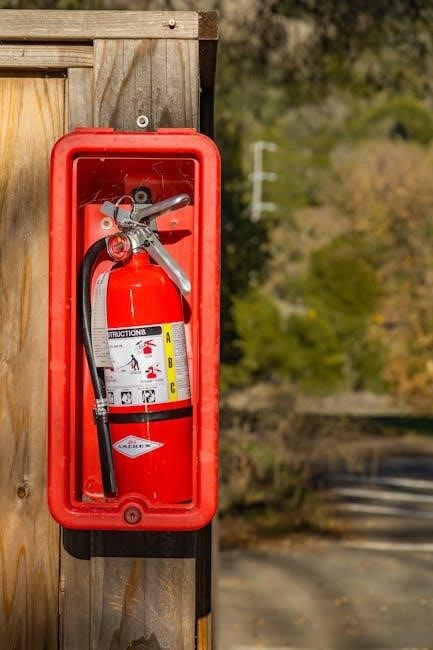
Fire extinguisher inspection tags are essential for tracking maintenance and ensuring compliance with safety regulations. They provide a clear record of inspections, helping organizations maintain safety standards and comply with legal requirements.
1.1 What Are Fire Extinguisher Inspection Tags?
Fire extinguisher inspection tags are physical labels attached to extinguishers, used to record essential details of inspections. They document the date, location, and inspector’s signature, ensuring compliance with safety standards. Available as printable PDF templates, these tags provide a clear and organized way to track maintenance, helping organizations maintain safety and meet legal requirements effectively.
1.2 Importance of Inspection Tags for Workplace Safety
Inspection tags are crucial for ensuring fire extinguishers are functional and ready for emergencies. They provide a clear record of maintenance, helping organizations comply with safety standards like NFPA and OSHA. Printable templates offer a cost-effective way to track inspections, ensuring workplace safety and reducing potential hazards. Regular updates on tags prevent oversight, making them indispensable for maintaining a secure environment.

Types of Fire Extinguisher Inspection Tags
Fire extinguisher inspection tags include monthly, annual, and service tags, each designed to track specific maintenance activities and ensure compliance with safety standards.
2.1 Monthly Inspection Tags
Monthly inspection tags are crucial for documenting regular checks of fire extinguishers. They record the date, location, and condition of each unit, ensuring visibility and accountability. These tags help maintain workplace safety by providing a quick reference for inspection status. Printable templates make it easy to create and update these tags efficiently, ensuring compliance with safety standards and regulations.
2.2 Annual Inspection Tags
Annual inspection tags are required for fire extinguishers to confirm they meet safety standards. These tags document detailed checks by certified professionals, including service dates and signatures. Printable templates simplify the process, ensuring all necessary information is recorded. They serve as proof of compliance with regulations like NFPA and OSHA, providing a clear and durable record for authorities and audits.
2.3 Service and Maintenance Tags
Service and maintenance tags are used after professional inspections or servicing. They provide detailed records of work done, including dates, technician signatures, and remarks. Printable templates ensure consistency and compliance with safety standards. These tags are essential for tracking the history of each extinguisher, ensuring reliability and adherence to regulations like NFPA and OSHA. They help maintain workplace safety and provide clear documentation for audits.

Benefits of Using Printable Fire Extinguisher Inspection Tags
Printable fire extinguisher inspection tags offer cost-effectiveness, customization, and ensure compliance with safety regulations, enhancing workplace safety and record-keeping efficiency while maintaining clear documentation standards.
3.1 Cost-Effectiveness and Convenience
Printable fire extinguisher inspection tags are a budget-friendly solution, eliminating the need for expensive pre-printed tags. They offer flexibility, allowing users to download and print only what’s needed, reducing waste. Free templates available online further enhance cost savings. Their convenience ensures inspections are efficiently documented, saving time and resources while maintaining compliance and workplace safety standards.
3.2 Customization Options
Printable fire extinguisher inspection tags offer high customization, allowing users to tailor templates to specific needs. Fields for location, date, signature, and remarks can be edited, ensuring clarity. Visual elements like checkboxes or color-coding enhance readability. Additionally, templates can be modified to include company logos or specific instructions, making them adaptable to various workplaces while maintaining professional and organized records. This flexibility ensures efficiency and accuracy in inspection documentation.
3.4 Compliance with Safety Regulations
Using printable fire extinguisher inspection tags ensures adherence to NFPA and OSHA standards. These templates often include fields for dates, signatures, and remarks, aligning with regulatory requirements. Regular updates and proper record-keeping demonstrate compliance, reducing legal risks. By maintaining accurate and accessible inspection records, organizations can meet safety standards effectively and ensure workplace safety is prioritized consistently over time. Compliance is made straightforward with these structured templates.

How to Create or Customize Inspection Tags
Design inspection tags using templates in PDF format, including essential details like date, location, and signature fields. Add visual elements for clarity and ease of use.
4.1 Designing Inspection Tags in PDF Format
Designing inspection tags in PDF format involves using software like Adobe Acrobat or free tools to create editable templates. Include fields for the extinguisher’s location, inspection date, and inspector’s signature. Add checkboxes or sections for visual inspection results, such as damage or pressure levels. Use clear fonts and layouts to ensure readability. Consider adding QR codes or color-coding for enhanced functionality and quick reference.
4.2 Including Essential Information (Date, Location, Signature)
Essential information includes the inspection date, location of the extinguisher, and the inspector’s signature. These details ensure accountability and traceability. The date confirms when the inspection occurred, the location helps in tracking the extinguisher, and the signature verifies the inspector’s approval. Including these elements in the template ensures compliance with safety standards and provides a clear audit trail for regulatory inspections. This information must be legible and accurately recorded.
4.3 Adding Visual Elements for Clarity
Visual elements like icons, color coding, and checklists enhance clarity. Icons quickly indicate the type of extinguisher or inspection status. Color coding highlights pass/fail results. Checklists simplify verification processes. These elements ensure critical information is easily understood, reducing errors. They also make the tags more user-friendly, especially for those with limited training. Visual elements complement textual information, ensuring inspections are conducted efficiently and accurately. This improves overall safety and compliance.

Step-by-Step Guide to Using Printable Templates
Visual elements like icons, charts, and color-coded sections enhance clarity. Icons simplify recognition of inspection status, while charts organize data. Color coding highlights critical information, ensuring quick comprehension. Adding images or diagrams can illustrate proper inspection steps. These elements make the tags more intuitive, reducing interpretation errors. Visual clarity is essential for ensuring inspections are performed correctly and efficiently, promoting workplace safety and compliance with regulations. Proper design improves overall usability;
5.1 Downloading the Template
Download printable fire extinguisher inspection tags templates in PDF format from trusted sources like Harold Cheever or Jan Tucker’s blog. These templates are free, easy to access, and customizable. Ensure the template includes sections for date, location, and signature. Choose templates that comply with NFPA and OSHA standards. Save time by selecting pre-designed layouts tailored for monthly or annual inspections. Multiple templates are available online, offering flexibility for different workplace needs.
5.2 Filling Out the Inspection Details
Fill out the inspection details accurately, including the date, location, and fire extinguisher number. Check the pressure gauge and ensure it’s in the green range. Record any visible damage, corrosion, or leakage. Note the initials of the inspector and add remarks for any issues found. Ensure all information is legible and complete, as incomplete data can lead to compliance issues. Follow the template’s guidelines for consistency.
5.3 Printing and Attaching the Tags
Print the completed inspection tags on durable material for longevity. Ensure the text is clear and legible. Attach the tags securely to the fire extinguisher using a sturdy method, such as a tamper-evident tie or adhesive. Make sure the tag is easily visible and not obstructed. Avoid attaching tags in a way that could damage the extinguisher or hinder its use. Proper attachment ensures the tag remains intact for future inspections.

Legal and Compliance Requirements
Adhering to NFPA and OSHA standards is crucial. Regular inspections and proper tagging ensure compliance, maintaining workplace safety and avoiding legal penalties. Printable templates help track inspections accurately.
6.1 NFPA Standards for Fire Extinguisher Inspections
NFPA standards mandate regular fire extinguisher inspections to ensure functionality and safety. Monthly visual checks and annual professional inspections are required, with records maintained via tags or digital systems. Printable templates help organizations comply by providing structured formats for documenting inspection dates, results, and signatures, ensuring adherence to NFPA guidelines and promoting workplace safety effectively.
6.2 OSHA Regulations on Workplace Safety
OSHA regulations require employers to ensure fire extinguishers are inspected regularly for functionality and accessibility. Monthly visual inspections and annual professional inspections are mandated, with records maintained. Printable inspection tags help organizations comply by providing a clear, documented history of inspections, ensuring workplace safety and adherence to OSHA standards effectively.
6.3 Record-Keeping Requirements
Record-keeping is critical for compliance, requiring detailed documentation of all fire extinguisher inspections. Printable tags must include dates, locations, and signatures, ensuring traceability. These records, whether physical or digital, must be maintained for audits and legal purposes. Accurate and complete documentation is essential to verify adherence to safety standards and provide proof of inspection history, supporting workplace accountability and safety protocols effectively.

Best Practices for Conducting Fire Extinguisher Inspections
Regular monthly inspections and annual professional checks are vital. Ensure extinguishers are accessible, pressure gauges are within range, and no damage is present. Use printable tags to document findings accurately.
7.1 Monthly Visual Inspections
Conducting monthly visual inspections ensures fire extinguishers are in good condition. Check for damage, corrosion, and proper pressure levels. Verify the safety pin is intact and the nozzle is unobstructed. Using printable inspection tags, record the date, location, and any issues found. This practice helps maintain compliance and ensures readiness in emergencies.
7.2 Annual Professional Inspections
Annual professional inspections are conducted by certified technicians to ensure fire extinguishers are fully functional. These inspections include internal examinations, recharge checks, and hydrostatic testing for certain types, like water or CO2 extinguishers. Using printable tags, technicians record the inspection date, results, and any necessary follow-up actions. This ensures compliance with safety standards and maintains a clear record of extinguisher maintenance.
7.3 Documenting Inspection Results
Accurate documentation of inspection results is critical for maintaining fire safety compliance. Printable tags and checklists provide a structured way to record inspection dates, locations, and outcomes. Digital tools or physical logs can also be used to store this information. Proper documentation ensures accountability, helps track maintenance history, and provides quick reference during audits or emergencies, safeguarding workplace safety and regulatory adherence.

Examples of Printable Inspection Tag Templates
Printable templates include basic monthly tags, detailed annual reports, and multi-extinguisher sheets. These documents provide structured spaces for recording essential details like inspection dates, locations, and signatures.
8.1 Basic Monthly Inspection Tags
Basic monthly tags are straightforward, featuring sections for the extinguisher number, location, inspection date, and inspector’s signature. They ensure regular checks are documented efficiently, providing a quick reference for compliance and maintenance tracking. These tags are ideal for facilities with multiple extinguishers, offering a simple yet effective way to stay organized and maintain workplace safety standards consistently.
8.2 Detailed Annual Inspection Reports
Detailed annual inspection reports provide a comprehensive record of fire extinguisher condition, including thorough checks of pressure, seals, and nozzles. These reports, often completed by certified professionals, include the service date, inspector’s signature, and any noted defects or required actions. They ensure compliance with safety standards and serve as a permanent record for future reference, highlighting the importance of regular, in-depth maintenance to ensure reliability in emergencies.
8.3 Multi-Extinguisher Inspection Sheets
Multi-extinguisher inspection sheets are designed to manage inspections for multiple fire extinguishers in a single document. These templates streamline the process by allowing users to record details for several units on one sheet, including location, inspection date, and signature. They are ideal for facilities with numerous extinguishers, reducing administrative effort and ensuring all safety checks are tracked efficiently in one place;

Common Mistakes to Avoid When Using Inspection Tags
Common mistakes include forgetting to update tags post-inspection, providing incomplete or illegible information, and failing to attach tags properly, which can lead to non-compliance and safety risks.
9.1 Forgetting to Update Tags After Inspections
Forgetting to update inspection tags after checks is a critical oversight, leading to outdated records and potential non-compliance. Ensure all inspections are promptly documented to maintain accuracy and safety standards. Using printable templates with clear fields for dates and signatures can help prevent this mistake. Regular audits and digital reminders are also effective solutions to keep tags up-to-date and compliant with regulations like NFPA standards.
9.2 Incomplete or Illegible Information
Incomplete or illegible information on inspection tags can lead to confusion and non-compliance with safety standards. Ensure all details, such as dates, locations, and signatures, are clearly filled out. Using printable templates with designated fields helps prevent omissions. Double-checking entries before attaching tags is crucial for maintaining accurate records and ensuring workplace safety remains a priority. Legible handwriting or printed text is essential for readability and compliance.
9.4 Not Attaching Tags Properly
Improperly attaching inspection tags can lead to them being lost or damaged, making it difficult to verify inspection records. Tags should be securely fastened to the fire extinguisher using durable materials to ensure they remain visible and intact. Failure to attach tags correctly can result in compliance issues and potential safety risks if inspections are not properly documented or easily accessible;
Printable fire extinguisher inspection tags are crucial for maintaining workplace safety and compliance. They ensure inspections are documented, providing a clear record of fire extinguisher maintenance and readiness.
10.1 Summary of Key Points
Printable fire extinguisher inspection tags simplify compliance with safety standards, offering a cost-effective way to track inspections. They ensure clarity, organization, and accountability, while customization options meet specific workplace needs. Regular inspections, documented with these tags, enhance safety and preparedness. By maintaining accurate records, businesses can avoid violations and ensure equipment reliability, ultimately protecting lives and property from fire hazards.
10.2 Final Thoughts on Workplace Safety
Printable fire extinguisher inspection tags are a vital tool for ensuring workplace safety. They streamline inspection processes, improve accountability, and help prevent fire-related incidents. By prioritizing regular inspections and maintaining clear records, businesses can protect employees, assets, and operations. These tags are a simple yet effective way to foster a culture of safety and responsibility, ensuring compliance and preparedness in case of emergencies.

References and Resources
Find printable fire extinguisher inspection tags templates and safety guidelines on trusted websites like Harold Cheever and Jan Tucker’s blog for reliable resources and compliance.
11.1 Where to Find Printable Templates Online
Find printable fire extinguisher inspection tags templates on trusted websites like Harold Cheever and Jan Tucker’s blog. These sites offer free PDF and Excel templates designed for compliance. They include customizable fields for dates, locations, and signatures. Use specific search terms like “fire extinguisher inspection tags template PDF” to locate reliable resources. Always verify the source for updates and adherence to safety standards.
11.2 Recommended Safety Guidelines and Standards
Adhere to NFPA 10 and OSHA regulations for fire extinguisher inspections. Ensure monthly visual checks and annual professional inspections are documented. Use tags to record inspection dates, locations, and signatures. Maintain compliance by following guidelines for proper tagging and record-keeping. Regularly update your procedures to align with the latest safety standards. Consult official resources for detailed requirements to ensure workplace safety and avoid non-compliance penalties.